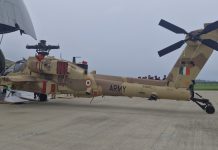The US Navy’s largest aircraft carrier, the USS Gerald R. Ford, was named the Atlantic Fleet’s ‘best’ all-around ship based on a cumulative list of accomplishments.
During a ceremony held aboard the carrier at Naval Station Norfolk on September 30, Adm. Daryl Caudle, U.S. Fleet Forces Command commander, presented the CVN-78 or the USS Gerald R. Ford crew with the 2024 Battenberg Cup award.
The Battenberg Cup is awarded to the ship or submarine that best embodies the spirit of the Atlantic Fleet, as determined by crew accomplishments.
“Ford’s unmatched successes in 2023 have more than validated its namesake of ‘Integrity at the Helm,’” said Caudle. He added: “Ford’s exceptional achievements as a frontline combat ship in the Atlantic Fleet are a direct tribute to the steadfast leadership, dedication, and consistently high performance of the Wardroom, the Chief Petty Officers, and the entire crew.”
The U.S. commander further noted that Ford successfully fulfilled the rigorous demands of a carrier strike group deployed to the theatres of operation of the U.S. Fifth and Sixth Fleets. The carrier facilitated multinational exercises of numerous combatant commands with seamless integration with Allied and Coalition Navies and Joint U.S. services.
Constructed in 2017, the USS Gerald R. Ford is the lead ship in the Navy’s new Ford carrier class and has been dubbed the “most adaptable and lethal combat platform in the world” by the US Navy. Ford is currently the biggest aircraft carrier in the world by size and is projected by Washington as being the most advanced in the world.
Congratulations to @CVN78_GRFord for being named best all-around ship in the Atlantic Fleet! 🥳🎊👏🎉
MORE: https://t.co/1XDy2NOxGW pic.twitter.com/ACxGbGCi6h
— U.S. Fleet Forces (@USFleetForces) September 30, 2024
As the first in her class, the ship represents a generational leap in the U.S. Navy’s capabilities. The carrier has implemented a range of innovative technologies, including the Advanced Arresting Gear (AAG), Advanced Weapons Elevators (AWE), and Electromagnetic Aircraft Launch System (EMALS), among others. With 20% fewer crew than a Nimitz-class carrier, the modern technologies on Ford-class ships have improved efficiency and capabilities and opened the doors for future naval aviation.
On receiving the title, Capt. Rick Burgess, Ford’s commanding officer said, “I could not be more proud of this crew. The sailors on this ship are extraordinary and incredibly smart. They make this ship what it is, and I look forward to what they will do in the future.”

The award and title have been bestowed on the ship based on a stellar operational record in a seemingly short period, especially after facing and overcoming a host of technical challenges that had delayed its initial operational deployment and cast doubts about its utility for the US Navy for a long time.
In 2022, the carrier made a brief operational deployment in the Atlantic when it participated in exercises with partners and allies across Europe. The Gerald R. Ford Carrier Strike Group joined six allies in the eastern Atlantic for Exercise Silent Wolverine conducted by NATO in November 2022.
The ship set sail on its maiden full-length deployment in May 2023 in European waters and was later rerouted to the East Mediterranean region for an extended deployment. It returned to its homeport at Norfolk, Virginia in January 2024, after what was described as a “historic” eight-month deployment.
The Ford-Class Has Demonstrated Its Efficiency
The USS Gerald R. Ford replaced the Nimitz-class carrier, the USS George H.W. Bush when it embarked on its first full deployment in May 2023 with its Carrier Strike Group. During this deployment across Europe and the Mediterranean, the carrier made port calls in Croatia, Greece, Italy, Norway, and Turkey.
The carrier was just six months into its maiden voyage and visiting NATO allies when war broke out between Israel and Hamas, and the carrier strike group had to be dispatched by the US Navy to the Eastern Mediterranean to deter a potential surge in hostilities. The US is Israel’s closest ally and has vowed to defend it under any and every circumstance.
At that time, CENTCOM stated: “The United States has begun moving USS Gerald R. Ford Carrier Strike Group to the Eastern Mediterranean. This includes the US Navy aircraft carrier USS Gerald R. Ford (CVN-78), the Ticonderoga-class guided-missile cruiser USS Normandy (CG 60), as well as the Arleigh-Burke-class guided missile destroyers USS Thomas Hudner (DDG 116), USS Ramage (DDG 61), USS Carney (DDG 64), and USS Roosevelt (DDG 80).”
As the situation in the region worsened, the deployment of the Carrier Strike Group was extended by 76 days. The crew of the carrier said later that it was because of these extensions that the Ford and its strike group were positioned to provide a flattop deterrent against any other regional entities who could try leveraging the Israel-Hamas conflict as a springboard for a larger escalation.
The Arleigh-Burke-class guided-missile destroyer USS Thomas Hudner, part of the Ford strike group, engaged several Houthi-launched drones and established its combat efficacy.
The group’s deployment ended earlier this year when it sailed back to Naval Station Norfolk, Virginia on January 17. Ford’s Commanding Officer, Capt. Rick Burgess marked the end of this ‘historic’ deployment saying: “Though extended, we were the right ship at the right time to answer the call, and our sailors performed admirably.”
An official statement published by the US Navy at the end of deployment read: “In 239 days underway, the ship’s crew conducted 43 underway replenishments, logged more than 17,826 flight hours and 10,396 sorties, sailed more than 83,476 nautical miles, and safely transferred 20.7 million gallons of fuel with zero mishaps. The Ford crew conducted 33,444 flight deck moves, 3,124 hangar bay aircraft moves, 2,883 aircraft elevator moves, 16,351 aircraft fueling evolutions, and transferred 8,850 pallets of cargo and mail.”
Although the USS Ford R. Gerald did not intercept any drones or missiles in the Red Sea, analysts pointed out that the deployment of the carrier allowed the US Navy to enforce deterrence in the region and justify the combat utility of the aircraft carrier that had earlier struggled with technological setbacks for years after being delivered to the US Navy.
After joining the fleet in 2017, it took six years for the Ford to finish its first full deployment due to cost overruns and technical difficulties. The Ford has experienced significant issues with its sophisticated electromagnetic aircraft catapults, electronically-tuned arresting gear, armament elevators, radars, and other systems.
At the time of delivery in 2017, the Ford was already billions of dollars over budget and further incurred additional costs due to various technical challenges, among other factors. It is believed to be the most expensive aircraft carrier in the world and has a price tag of at least $13.3 billion, which is approximately $3 billion higher than initial projections. This significant increase raised many eyebrows in the country, with critics arguing against the ballooning costs.
The carrier, in its inaugural full deployment, showcased its effectiveness in combat and its capability for power projection on a global scale. The award provides further confirmation for this carrier-class, which is expected to see more inductions in the future.
- Contact the author at sakshi.tiwari9555(at)gmail.com
- Follow EurAsian Times on Google News




